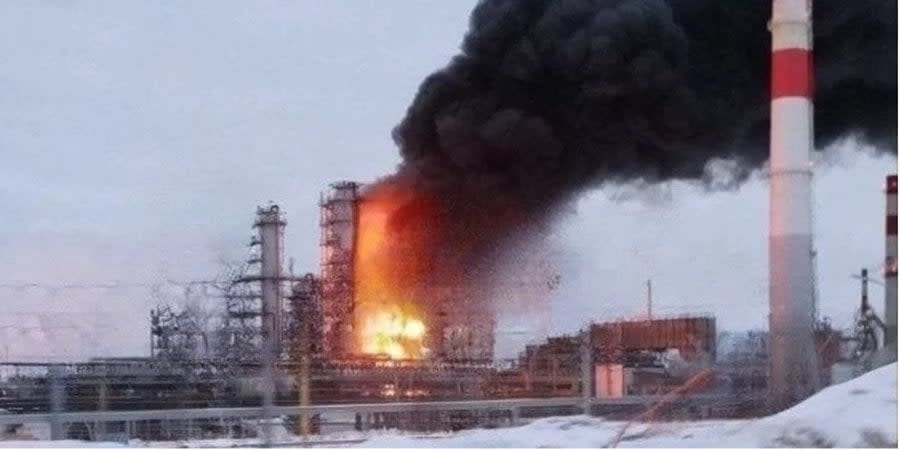Ukraine’s drone strike campaign against Russian oil refineries

The strategic operation against the Russian oil industry is a triumph of tactics, weapons, and management.
Ukrainian defense forces for the first time conducted a large-scale operation to attack a strategic sector of the Russian economy—oil refining—over two months, from Jan. 24 to March 25, 2024. Russian air defenses offered desperate resistance, but thanks to high-quality planning, coordination and the high quality of Ukrainian-made drones, our drone operators hit 10 oil refineries, one LNG [liquified natural gas] facility, and one regional power plant (GRES).
Read also: Deputy PM Stefanishyna comments on US calls to cease strikes on Russian refineries
Previously, during this war, Russia suffered only one strategic blow to its economy: the destruction of Nord Stream natural gas pipelines in 2022, which Russia used to blackmail Europe and receive excess profits from the European Union.
But Ukrainian drone strikes open new opportunities for economic warfare against Russia, damage to Russian infrastructure and industry on a much larger scale.
Read also:
Attacks on Russian refineries may affect global oil supply — report
Drone attacks halt nitrate transshipment at large St Petersburg port, causing significant cargo loss
The results of drone strikes
The following Russian facilities were partially or completely disabled:
1. Tuapse Oil Refinery;
2. Nizhny Novgorod Oil Refinery;
3. Ryazan Oil Refinery;
4. Novokuibyshevsk Oil Refinery;
5. Syzran Oil Refinery;
6. Slavyansk Oil Refinery;
7. Ilsky Oil Refinery;
8. Volgograd Oil Refinery;
9. Novoshakhtinsk Oil Refinery;
10. Kuibyshev Oil Refinery;
11. Ust-Luga LNG plant;
12. Novocherkassk GRES.
The refineries’ most vulnerable modules—rectification columns—were chosen as targets. Ukrainian experts estimate direct losses from the destruction of this valuable equipment to be about $1.5 billion.
Indirect losses, including a drop in refining capacity of the Russian oil industry, are estimated at more than 70 million tons per year, which is more than 25% of all Russian capacity.
This led to:
— a 50% increase in gasoline prices in Russia;
— a ban on gasoline exports from Russia (a $2 billion loss for the state budged $4 billion in lost revenue from oil companies);
— reduction of production by 500,000 barrels per day (annual losses can reach $12 billion);
— significant reduction in fuel supply to the Russian military.
New tactics and weapons
This highly effective campaign was made possible thanks to a clear task assignment by Supreme Commander-in-Chief Volodymyr Zelenskyy (yes, no matter how strange it sounds, but for the first time during the war it’s worth noting the foresight in decision-making Ukraine’s top political leadership) and the combination of Ukraine’s drone manufacturers and several segments of the country’s security forces. Various government structures were properly commanded for the first time during the war. The operation was properly funded, planned, and executed. [It was] an unprecedented event, the Ukrainian authorities have never taken any systemic actions before.
Lyutyi drones with a 50 kg warhead have shown their high combat effectiveness and reliability
For the first time, funds were allocated from the state budget to finance the production of the Lyutyi [Fierce] strike drone, the Ukrainian analogue of the Iranian-made Shahed kamikaze drones.
Lyutyi was developed a year ago, in 2023, proactively, without a state order, and this project had no attention and proper financing for a long time. However, financing and mass production have begun since January 2024. Lyutyi drones with a 50 kg warhead have shown their high combat effectiveness and reliability, resistance to Russian electronic warfare, and long operational range. The Kuibyshev Oil Refinery was hit from 900 km away, with the actual flight path of the drone being even longer.
The attacks became effective because, for the first time during the war, Ukraine’s SBU security service, Defense Intelligence (HUR), and the Armed Forces acted in unison during planning and operational development.
A single control coordination center was identified for the first time, and this the center of the Ukrainian Army’s Unmanned Forces, which have just been established, but are already producing results.
It’s important to note the role of the Army of Drones and the Digital Transformation Ministry in implementing the program.
Read also:
Russian vulnerabilities exposed by Ukrainian long-range drones
Ukraine’s strategic strikes aim to undermine Russia's economy and cut petrodollar flow to war effort
I congratulate all participants and leaders of the operation and hope that the scale of strikes on Russia will increase tenfold. The enemy must bear responsibility for the destruction of the Ukrainian economy. U.S. and EU sanctions have failed to reduce the value of Russian exports over two years, while Ukrainian drones have reduced them in just two months. And all this is done for a small amount of money, with a small number of drones.
This successful Ukrainian operation could become an example to follow in other warfare domains.
We’re bringing the voice of Ukraine to the world. Support us with a one-time donation, or become a Patron!
Read the original article on The New Voice of Ukraine

